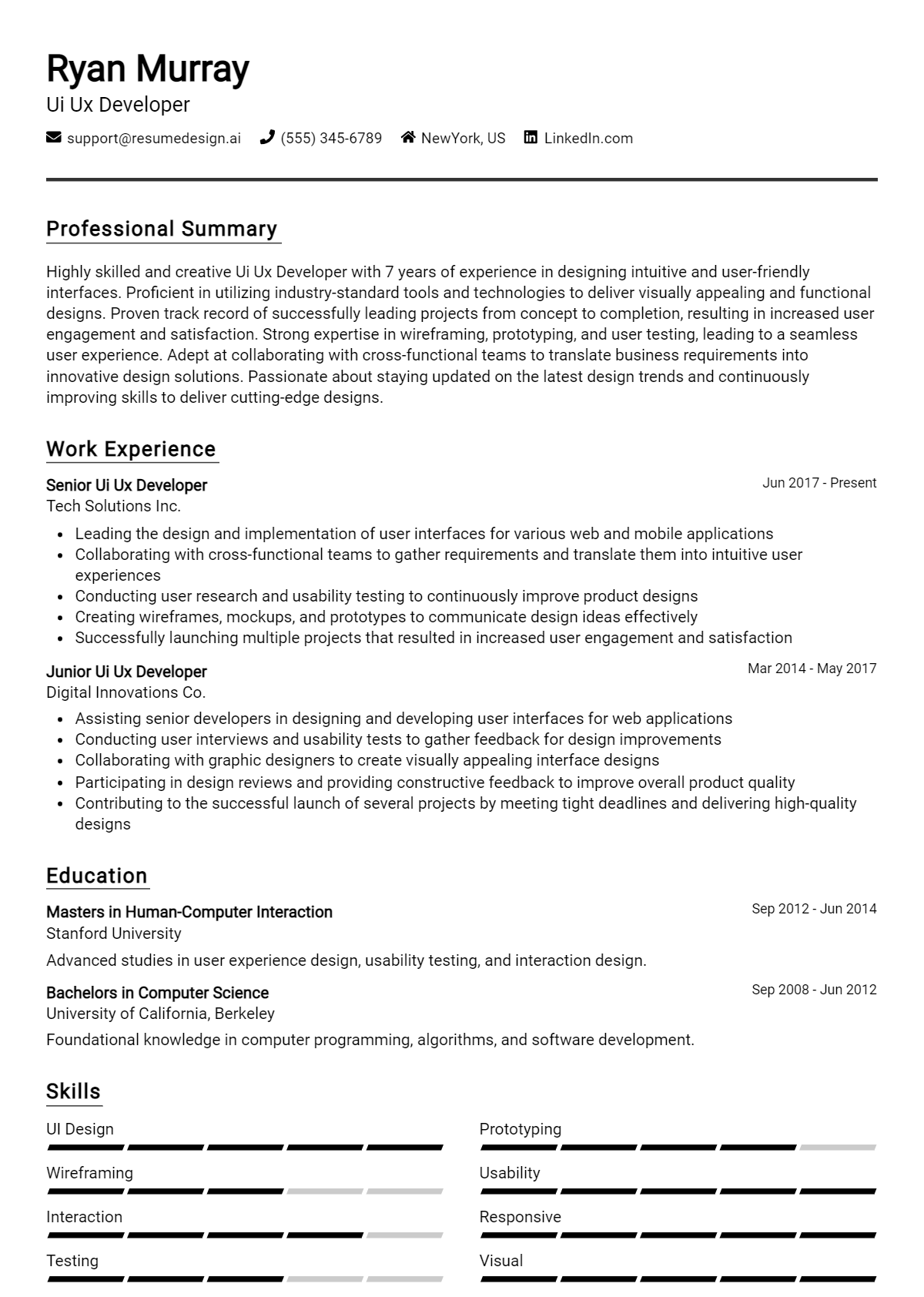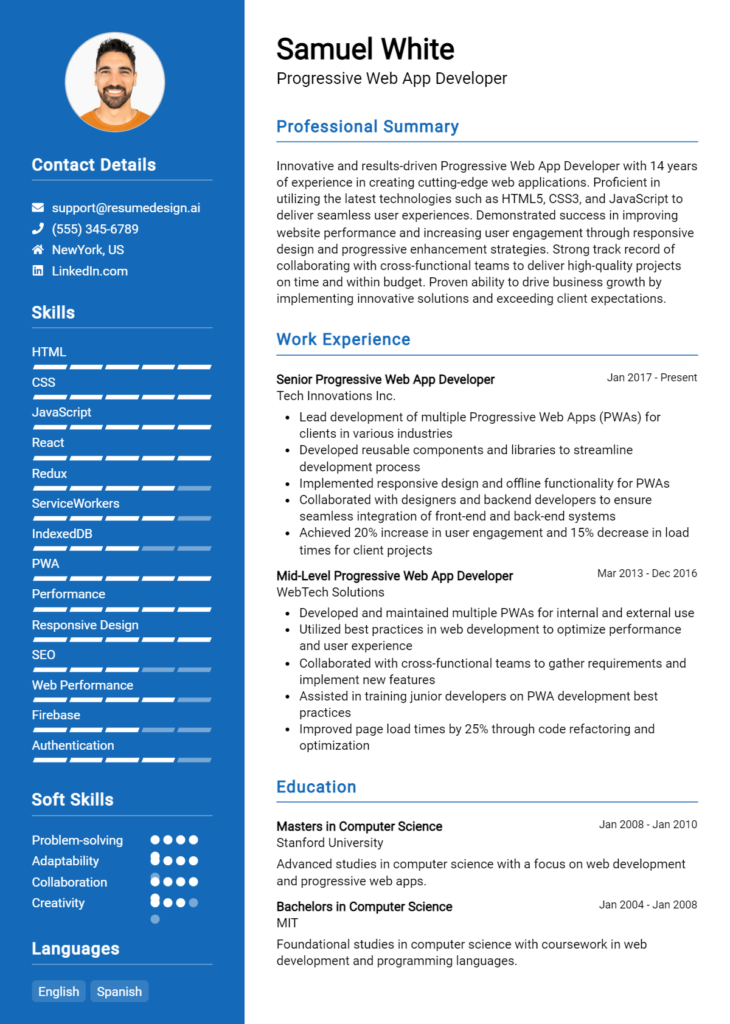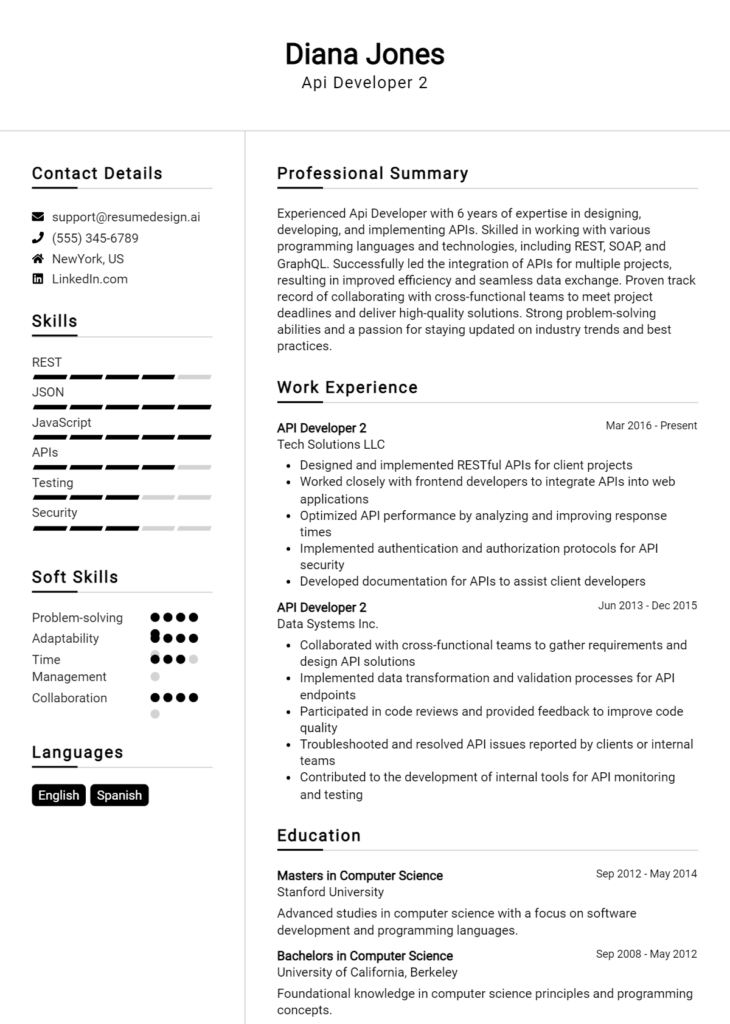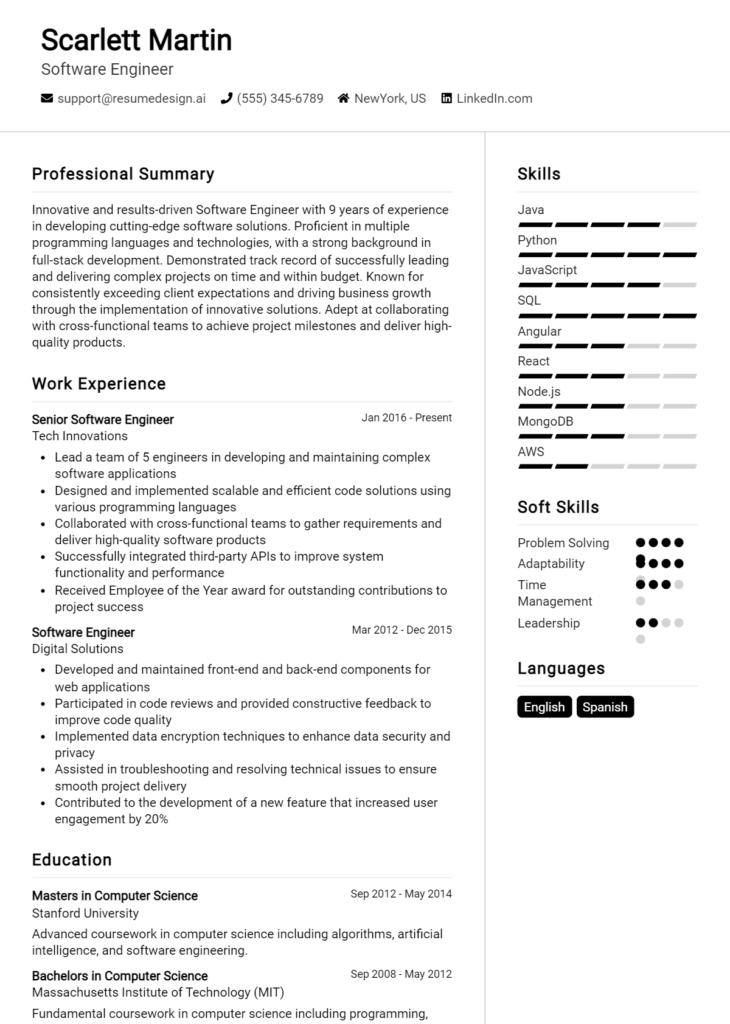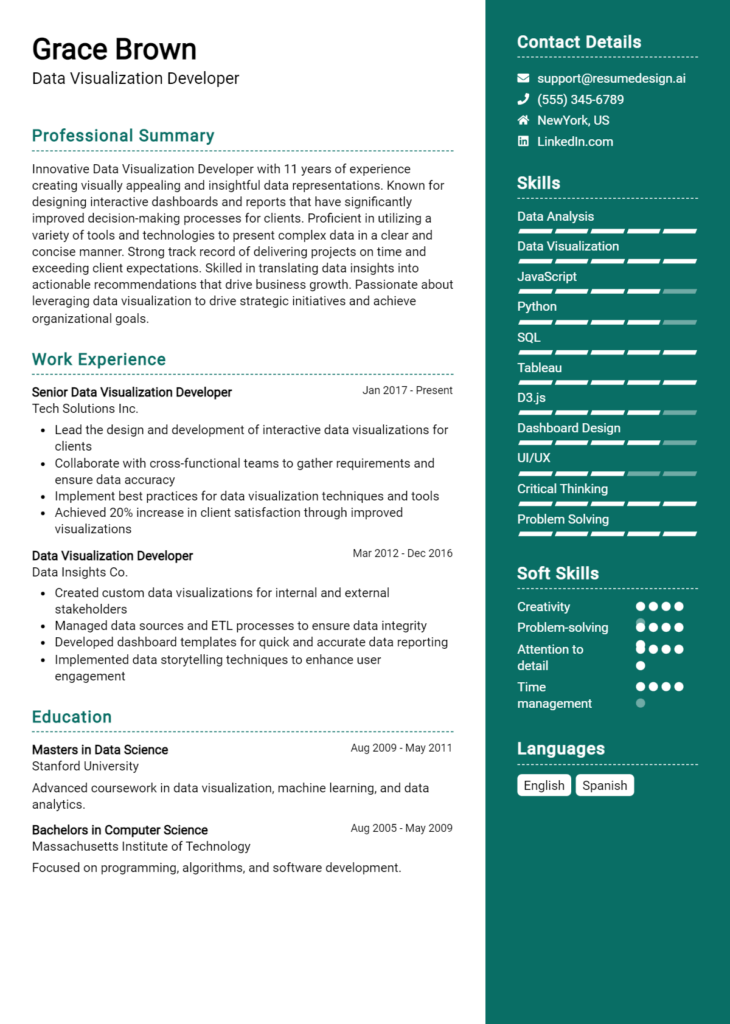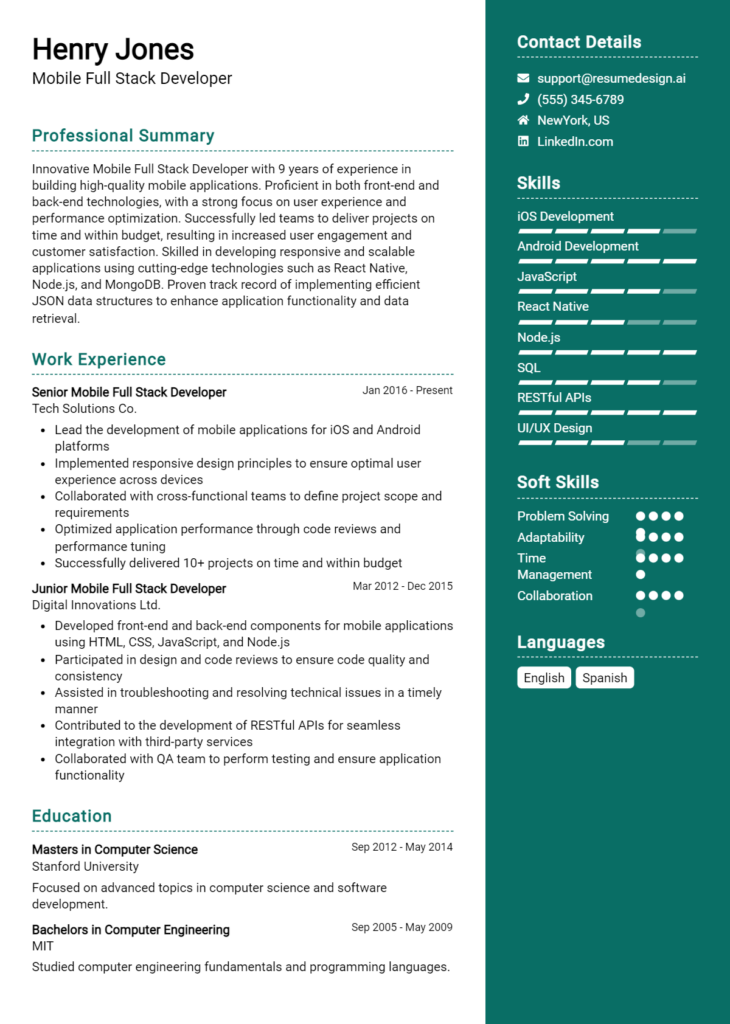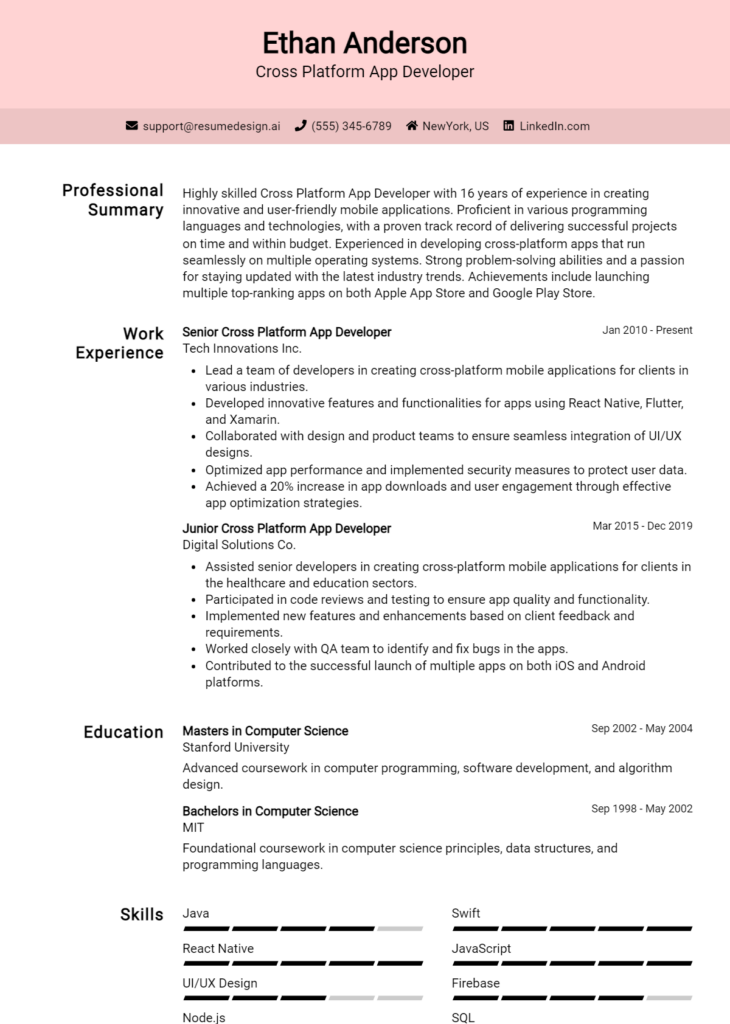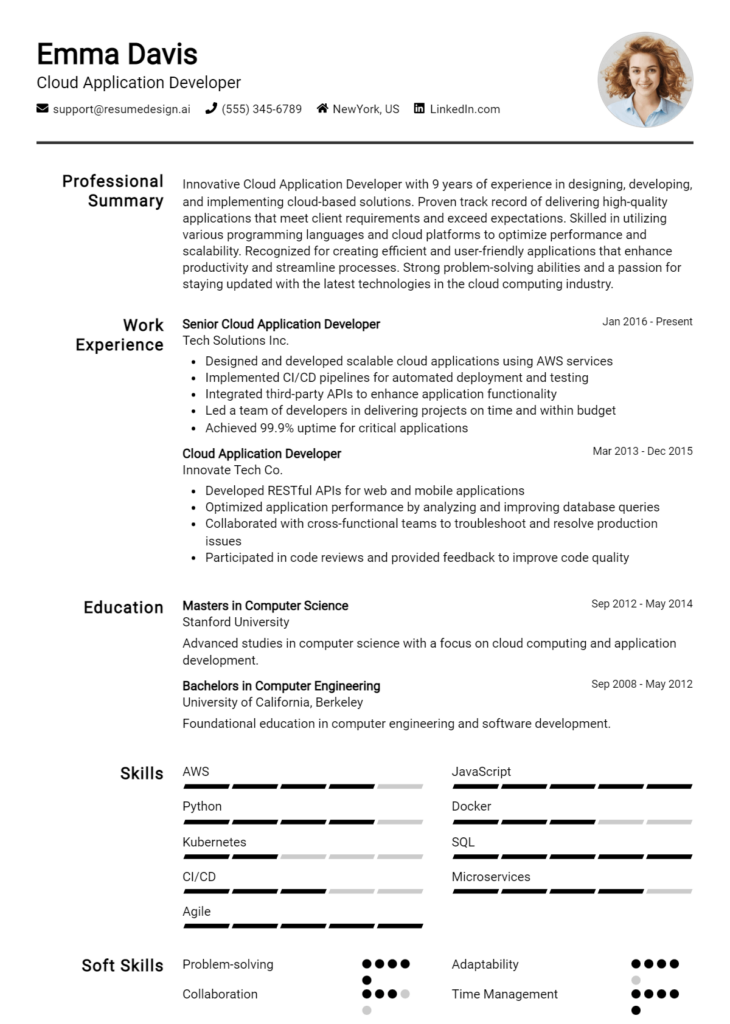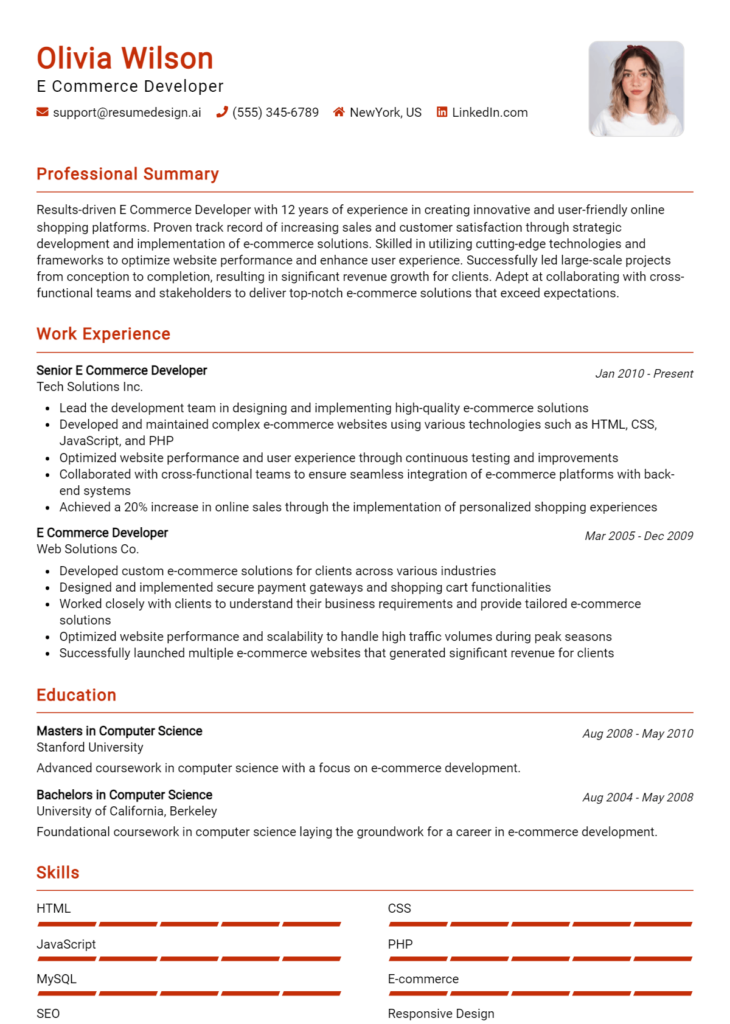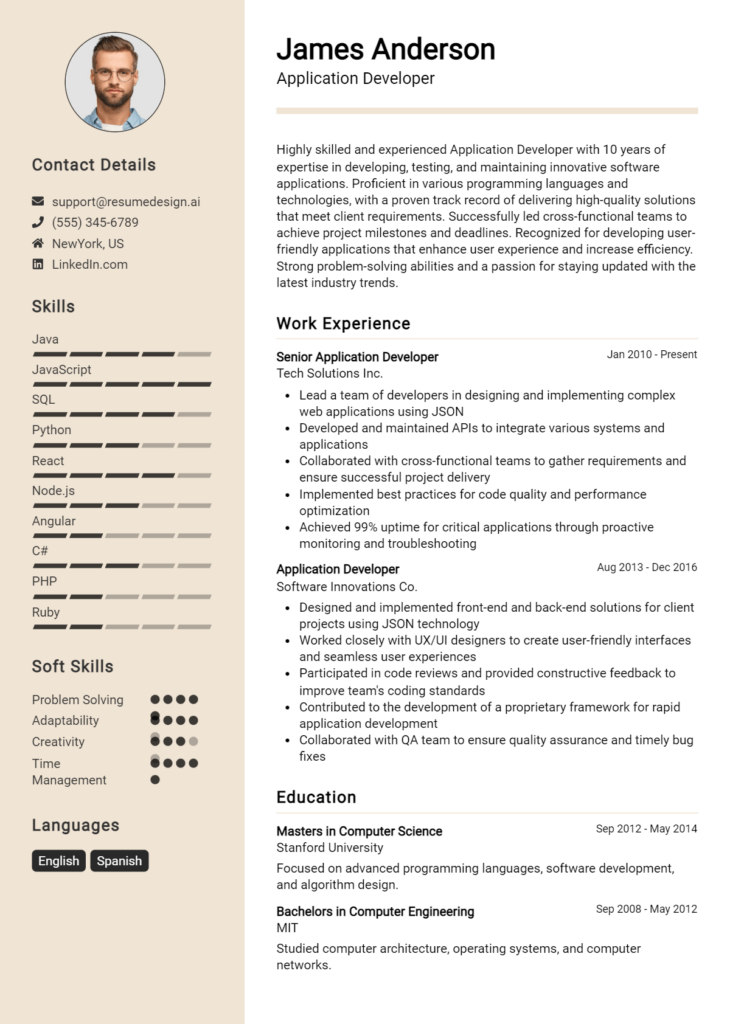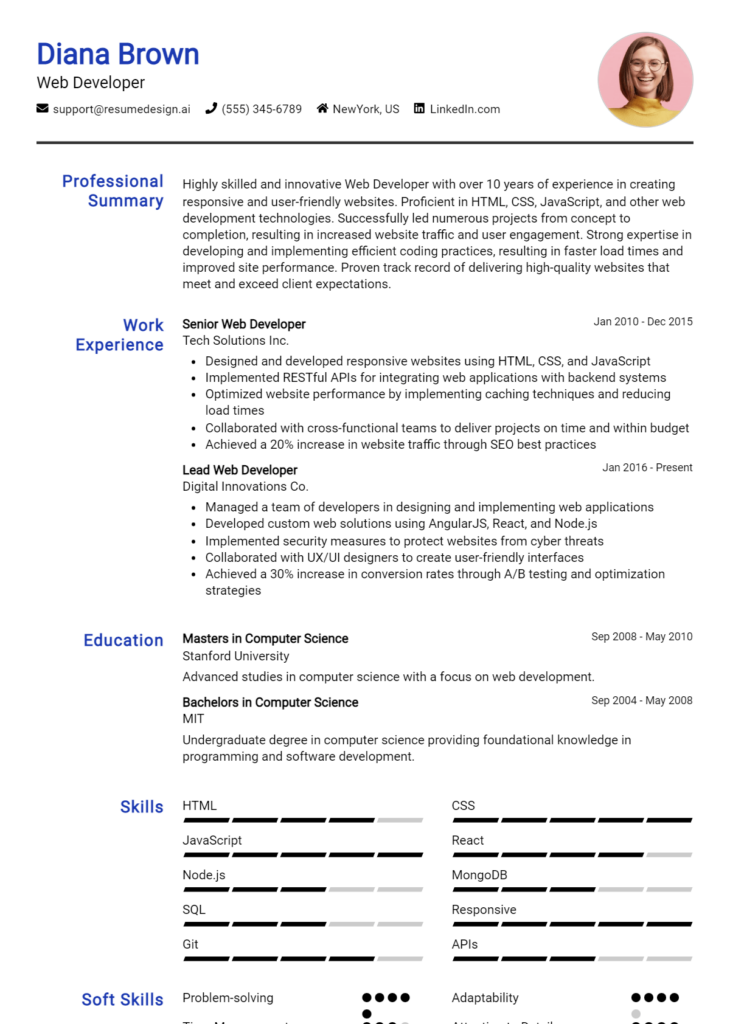UI/UX Developer Core Responsibilities
A UI/UX Developer plays a crucial role in creating intuitive and engaging user experiences. Key responsibilities include conducting user research, designing wireframes and prototypes, and collaborating with developers and product managers to ensure seamless product functionality. Essential skills encompass technical proficiency in design tools, operational understanding of user behavior, and strong problem-solving abilities. These competencies contribute significantly to achieving organizational goals by enhancing user satisfaction and retention. A well-structured resume can effectively highlight these qualifications, showcasing a candidate's ability to bridge diverse departments.
Common Responsibilities Listed on UI/UX Developer Resume
- Conducting user research and usability testing to gather insights.
- Creating wireframes, prototypes, and user flows to visualize design concepts.
- Collaborating with cross-functional teams, including developers and product managers.
- Designing responsive and visually appealing interfaces for web and mobile applications.
- Utilizing design tools such as Sketch, Figma, or Adobe XD for prototyping.
- Implementing user feedback to enhance product usability and functionality.
- Staying updated on industry trends and best practices in UI/UX design.
- Conducting A/B testing to optimize user interfaces and experiences.
- Creating and maintaining design documentation and style guides.
- Ensuring accessibility and inclusivity in design solutions.
- Analyzing user behavior metrics to inform design decisions.
High-Level Resume Tips for UI/UX Developer Professionals
In the competitive field of UI/UX development, a well-crafted resume is not just a document; it's your first chance to make a lasting impression on potential employers. Given the emphasis on design and user experience in this industry, your resume must effectively reflect not only your technical skills but also your creative achievements. A thoughtfully constructed resume can set you apart from the competition, showcasing your unique contributions and expertise. In this guide, we will provide practical and actionable tips specifically tailored for UI/UX Developer professionals to enhance your resume and increase your chances of landing that dream job.
Top Resume Tips for UI/UX Developer Professionals
- Tailor your resume for each job application by aligning your skills and experiences with the job description.
- Highlight relevant projects, showcasing your role, the tools used, and the impact of your work on the overall user experience.
- Quantify your achievements with metrics; for example, mention improvements in user engagement, conversion rates, or time saved through your design solutions.
- Include a portfolio link that showcases your best work, emphasizing your design process and the results achieved.
- Utilize industry-specific keywords and phrases that align with the skills and technologies mentioned in the job posting.
- Incorporate a summary statement at the top of your resume that captures your professional identity and key competencies in UI/UX development.
- List relevant technical skills, such as proficiency in design tools (e.g., Sketch, Figma, Adobe XD) and familiarity with front-end development languages (HTML, CSS, JavaScript).
- Keep your design clean and professional, using ample white space and a clear hierarchy to enhance readability.
- Showcase soft skills relevant to UI/UX roles, such as collaboration, empathy, and problem-solving abilities.
By implementing these tips, you can significantly enhance your resume, making it a powerful tool to capture the attention of hiring managers in the UI/UX field. A well-structured and tailored resume not only highlights your qualifications but also demonstrates your understanding of user-centered design principles, which is vital for success in this industry.
Why Resume Headlines & Titles are Important for UI/UX Developer
In the competitive field of UI/UX development, a resume headline or title serves as a critical first impression for hiring managers. It is the first element they encounter and sets the tone for the entire resume. A strong headline can immediately capture attention, summarizing a candidate's key qualifications in a concise and impactful phrase. This is essential in a fast-paced hiring environment where decisions are often made quickly. An effective headline should be relevant and directly related to the job being applied for, allowing the candidate to stand out among numerous applicants and effectively communicate their unique value proposition.
Best Practices for Crafting Resume Headlines for UI/UX Developer
- Keep it concise: Aim for one impactful phrase that summarizes your expertise.
- Make it role-specific: Tailor your headline to reflect the specific UI/UX position you are applying for.
- Highlight key skills: Include essential skills or technologies relevant to the job.
- Showcase accomplishments: If possible, incorporate a notable achievement to add credibility.
- Use action-oriented language: Utilize strong verbs to convey proactivity and impact.
- Incorporate industry keywords: Use terms that are common in the UI/UX field to enhance searchability.
- Avoid jargon: Ensure that your headline is easily understandable to a diverse audience, including HR personnel.
- Maintain professionalism: A polished and professional tone is crucial for making a good impression.
Example Resume Headlines for UI/UX Developer
Strong Resume Headlines
Creative UI/UX Developer with 5+ Years of Experience in User-Centered Design
Results-Driven UI/UX Designer Specializing in Mobile App Interfaces and Usability Testing
Innovative UI/UX Developer Focused on Enhancing User Engagement Through Data-Driven Design
Weak Resume Headlines
UI/UX Developer Looking for Opportunities
Experienced Designer
The strong resume headlines are effective because they clearly articulate the candidate's expertise, experience, and specific focus within the UI/UX domain, which helps hiring managers quickly assess their fit for the role. On the other hand, the weak headlines lack specificity and fail to communicate any unique value or qualifications, making them forgettable in a sea of applications. A compelling headline should always aim to capture attention and convey a sense of professionalism and relevance to the desired position.
Writing an Exceptional UI/UX Developer Resume Summary
A well-crafted resume summary is crucial for a UI/UX Developer as it serves as the first impression that hiring managers have of a candidate. This brief yet powerful section can quickly capture attention by highlighting the candidate's key skills, relevant experience, and notable accomplishments tailored to the role. A strong summary should be concise and impactful, providing insight into the candidate's unique qualifications that make them a perfect fit for the job they are applying for. In a competitive field like UI/UX development, a standout resume summary can significantly enhance the chances of landing an interview.
Best Practices for Writing a UI/UX Developer Resume Summary
- Quantify achievements: Use numbers and metrics to showcase your contributions and impact.
- Highlight relevant skills: Focus on the specific skills that align with the job description.
- Tailor the summary: Customize the summary for each job application to reflect the requirements of the position.
- Be concise: Limit the summary to 2-4 sentences to maintain clarity and focus.
- Showcase your design philosophy: Mention your approach to user-centered design and problem-solving.
- Use action verbs: Start sentences with strong action verbs to convey confidence and proactivity.
- Include industry-specific keywords: Incorporate terminology relevant to UI/UX to pass through applicant tracking systems.
- Emphasize collaboration: Highlight teamwork and communication skills, which are essential in UI/UX roles.
Example UI/UX Developer Resume Summaries
Strong Resume Summaries
Detail-oriented UI/UX Developer with over 5 years of experience in creating user-centric designs for web and mobile applications, resulting in a 30% increase in user engagement. Proficient in Adobe Creative Suite, Sketch, and Figma, with a proven record of collaborating with cross-functional teams to enhance user experience.
Innovative UI/UX Designer specializing in responsive web design and user research, with a track record of improving customer satisfaction ratings by 25% through iterative design processes. Skilled in wireframing, prototyping, and usability testing, dedicated to delivering exceptional digital experiences.
Results-driven UI/UX Developer with a focus on accessibility and inclusivity, enhancing user experience for diverse audiences. Successfully led a project that reduced bounce rates by 40% through strategic redesign and user feedback integration. Experienced in HTML, CSS, and JavaScript.
Weak Resume Summaries
I am a UI/UX Developer looking for a position where I can use my skills in design to help companies improve their websites.
Enthusiastic designer with some experience in UI/UX. I want to work in a dynamic environment and contribute to team projects.
The strong resume summaries are effective because they include quantifiable achievements, specific skills, and direct relevance to the UI/UX role, making them compelling to hiring managers. In contrast, the weak summaries lack specificity, fail to showcase measurable outcomes, and come across as too generic, which diminishes their impact in a competitive job market.
Work Experience Section for UI/UX Developer Resume
The work experience section of a UI/UX Developer resume is vital as it serves as a platform for candidates to demonstrate their technical skills, leadership abilities, and capacity to deliver high-quality products. This section not only illustrates the practical application of design principles and tools but also underscores the candidate's experience in collaborating with cross-functional teams. By quantifying achievements and aligning their experience with industry standards, candidates can effectively communicate their value to potential employers, making this section a critical component of a successful resume.
Best Practices for UI/UX Developer Work Experience
- Highlight relevant technical skills and tools used in each project.
- Quantify achievements with metrics, such as improved user engagement or reduced load time.
- Showcase leadership experience in managing teams or projects.
- Detail collaborative efforts with cross-functional teams, such as developers and product managers.
- Use action verbs to convey a sense of impact and initiative.
- Align your experiences with industry standards and expectations for UI/UX roles.
- Include a variety of projects that demonstrate versatility in design and problem-solving.
- Focus on outcomes and user feedback to illustrate the effectiveness of your designs.
Example Work Experiences for UI/UX Developer
Strong Experiences
- Led a team of 5 designers in a redesign project that increased user satisfaction scores by 30% within three months.
- Developed a mobile app interface that resulted in a 40% increase in user retention, as evidenced by analytics tracking.
- Collaborated with developers to implement a new design system that reduced development time by 25%, enhancing overall workflow efficiency.
- Conducted user research and usability testing that informed design decisions, leading to a 50% decrease in user errors reported post-launch.
Weak Experiences
- Worked on various projects related to UI/UX design.
- Participated in team meetings discussing design ideas.
- Helped improve website navigation.
- Involved in user testing sessions.
The examples listed as strong experiences clearly demonstrate quantifiable outcomes, technical leadership, and meaningful collaboration within teams, providing a compelling narrative of the candidate's impact. In contrast, the weak experiences lack specificity and measurable achievements, failing to convey the candidate's true capabilities and contributions in the UI/UX field. Strong experiences engage potential employers by showcasing the candidate's effectiveness and results-driven approach, while weak experiences do not provide enough detail to make a lasting impression.
Education and Certifications Section for UI/UX Developer Resume
The education and certifications section of a UI/UX Developer resume plays a crucial role in establishing the candidate's qualifications and expertise in the field. This section not only showcases the academic background of the applicant but also highlights any industry-relevant certifications and continuous learning efforts that demonstrate a commitment to staying current with evolving trends and technologies. By including relevant coursework, recognized certifications, and specialized training, candidates can significantly enhance their credibility and better align themselves with the specific requirements of the job role, thereby making a compelling case to potential employers.
Best Practices for UI/UX Developer Education and Certifications
- Focus on relevant degrees, such as Computer Science, Graphic Design, or Human-Computer Interaction.
- Include industry-recognized certifications like Certified Usability Analyst (CUA) or Google UX Design Certificate.
- List coursework that relates directly to UI/UX principles, design thinking, and user research methodologies.
- Highlight any specialized training in tools and technologies commonly used in UI/UX, such as Adobe XD, Figma, or Sketch.
- Keep the section concise, providing only the most pertinent information to maintain clarity and focus.
- Order entries chronologically, starting with the most recent qualifications to showcase ongoing professional development.
- Consider adding links to online courses or bootcamps that are well-regarded in the UI/UX community.
- Be mindful of the credibility of the institutions and organizations from which the education and certifications were obtained.
Example Education and Certifications for UI/UX Developer
Strong Examples
- Bachelor of Arts in Graphic Design, University of California, Los Angeles (UCLA), 2021
- Google UX Design Professional Certificate, Coursera, 2022
- Certification in User Experience Research and Design, Nielsen Norman Group, 2023
- Coursework in Interaction Design, Human-Computer Interaction, and Usability Testing
Weak Examples
- Bachelor of Science in Biology, State University, 2018
- Certification in Microsoft Office Suite, Online Course, 2020
- High School Diploma, Local High School, 2016
- Coursework in Ancient History and Philosophy
The strong examples are considered effective because they directly relate to the skills and knowledge required for a UI/UX Developer role, showcasing relevant degrees and contemporary certifications that are well-respected in the industry. In contrast, the weak examples reflect qualifications that do not pertain to the UI/UX field, either due to their irrelevance to design and user experience or because they represent outdated or overly generalized skills that do not enhance the candidate's suitability for the position.
Top Skills & Keywords for UI/UX Developer Resume
In the competitive field of UI/UX development, showcasing the right blend of skills on your resume is crucial for standing out to potential employers. A well-crafted resume not only highlights your technical abilities but also emphasizes your soft skills, which are equally important in creating user-centered designs and collaborating effectively within teams. By incorporating relevant skills and detailing your work experience, you can present a comprehensive picture of your capabilities that aligns with the demands of the role.
Top Hard & Soft Skills for UI/UX Developer
Soft Skills
- Communication
- Team Collaboration
- Problem-Solving
- Adaptability
- Empathy
- Time Management
- Critical Thinking
- Attention to Detail
- Creativity
- User Advocacy
Hard Skills
- Proficiency in design tools (e.g., Adobe XD, Sketch, Figma)
- HTML/CSS knowledge
- JavaScript basics
- Responsive Web Design
- Usability Testing
- Wireframing and Prototyping
- Information Architecture
- User Research and Analysis
- Graphic Design Principles
- Familiarity with version control systems (e.g., Git)
Stand Out with a Winning UI/UX Developer Cover Letter
Dear [Hiring Manager's Name],
I am writing to express my interest in the UI/UX Developer position at [Company Name] as advertised on [where you found the job listing]. With a strong background in both user interface design and user experience research, combined with my passion for creating intuitive and engaging digital experiences, I am excited about the opportunity to contribute to your team and help elevate your product offerings.
In my previous role at [Previous Company Name], I successfully led the redesign of our flagship application, resulting in a 30% increase in user engagement and a significant reduction in bounce rates. My approach to UI/UX development revolves around a deep understanding of user needs, which I achieve through comprehensive user research, usability testing, and iterative design processes. I am proficient in industry-standard tools such as Sketch, Figma, and Adobe Creative Suite, allowing me to create wireframes, prototypes, and high-fidelity designs that not only meet but exceed user expectations.
Collaboration is key in any successful project, and I pride myself on my ability to work closely with cross-functional teams, including developers, product managers, and stakeholders. I believe that the best results come from open communication and shared goals, and I am eager to bring my collaborative spirit to [Company Name]. I am particularly drawn to your commitment to innovation and user-centered design, and I am excited about the prospect of contributing my skills to help shape the future of your products.
Thank you for considering my application. I look forward to the opportunity to discuss how my background, skills, and enthusiasms align with the goals of [Company Name]. I am confident that my experience and passion for UI/UX development make me a strong candidate for this role.
Sincerely,
[Your Name]
[Your LinkedIn Profile or Portfolio]
[Your Contact Information]
Common Mistakes to Avoid in a UI/UX Developer Resume
When crafting a resume as a UI/UX Developer, it's crucial to present your skills and experience effectively to stand out in a competitive job market. Many candidates make avoidable mistakes that can undermine their chances of landing an interview. By being aware of these common pitfalls, you can refine your resume and showcase your qualifications more effectively. Here are some mistakes to steer clear of:
Lack of Tailoring: Sending out a generic resume for every job application can be detrimental. Tailor your resume to highlight the skills and experiences that align with the specific job description.
Neglecting Soft Skills: While technical skills are vital, UI/UX roles also require strong communication, collaboration, and problem-solving abilities. Failing to mention these can make your resume feel one-dimensional.
Overcomplicating Design: As a UI/UX Developer, your design skills should shine, but overly complex layouts can distract from the content. Keep your resume clean and easy to read.
Ignoring Metrics: Quantifying your achievements gives potential employers a clearer view of your impact. Avoid vague statements and instead, use numbers to demonstrate your contributions (e.g., "increased user satisfaction by 30%").
Inconsistent Formatting: A chaotic format can confuse recruiters. Ensure consistent font sizes, styles, and spacing to enhance readability and create a professional appearance.
Omitting a Portfolio: For UI/UX roles, a strong portfolio is essential. Failing to include a link to your work can leave hiring managers questioning your capabilities.
Listing Irrelevant Experience: Including unrelated job experiences can dilute your resume. Focus on roles that specifically relate to UI/UX design and development to maintain relevance.
Neglecting Continuous Learning: The tech field is always evolving. Not mentioning recent courses, certifications, or workshops can imply stagnation. Showcase your commitment to staying updated with industry trends and tools.
Conclusion
In conclusion, the role of a UI/UX Developer is crucial in creating engaging and user-friendly digital experiences. We’ve discussed the importance of understanding user needs, the significance of wireframing and prototyping, and the necessity of staying updated with the latest design trends and tools. As the digital landscape continues to evolve, so does the demand for skilled UI/UX professionals who can bridge the gap between aesthetics and functionality.
Now is the perfect time to evaluate your own resume to ensure it effectively showcases your skills and experience. A well-crafted resume can make a significant difference in landing your next job opportunity. To assist you in this endeavor, consider utilizing the following resources:
- Explore resume templates that can help you create a visually appealing document.
- Use the resume builder for a step-by-step approach to crafting your resume.
- Review resume examples for inspiration and guidance on how to present your qualifications.
- Don’t forget to complement your resume with a strong introduction by using our cover letter templates.
Take the next step in your career by refining your UI/UX Developer resume today!

